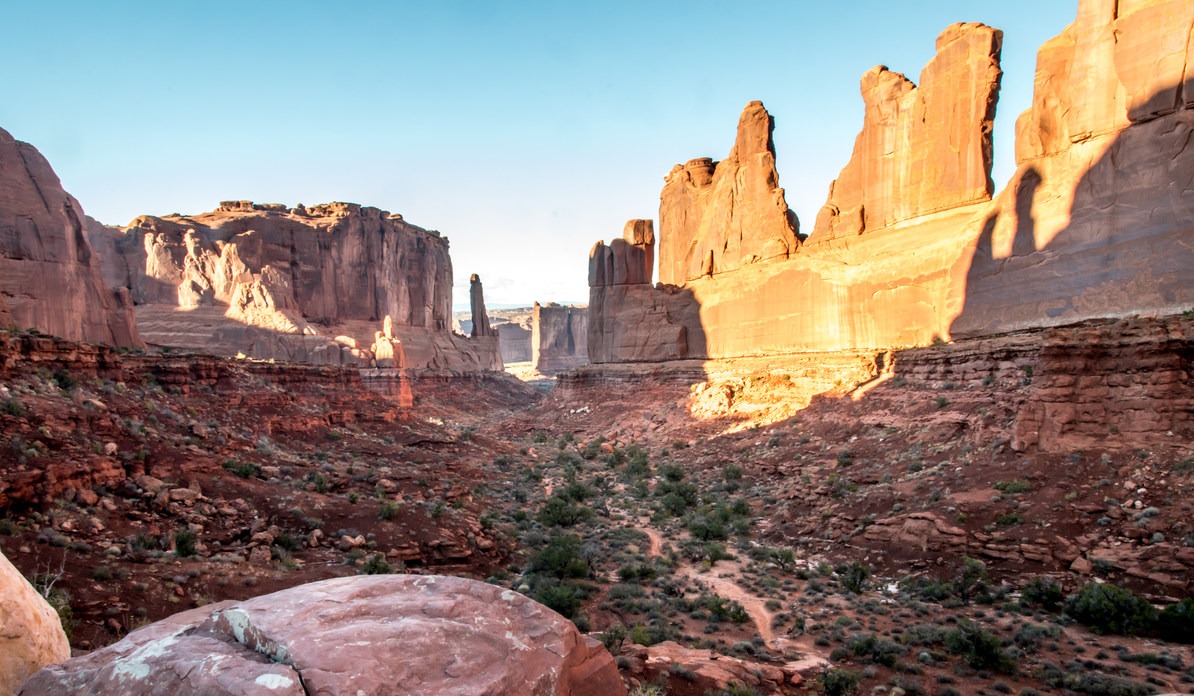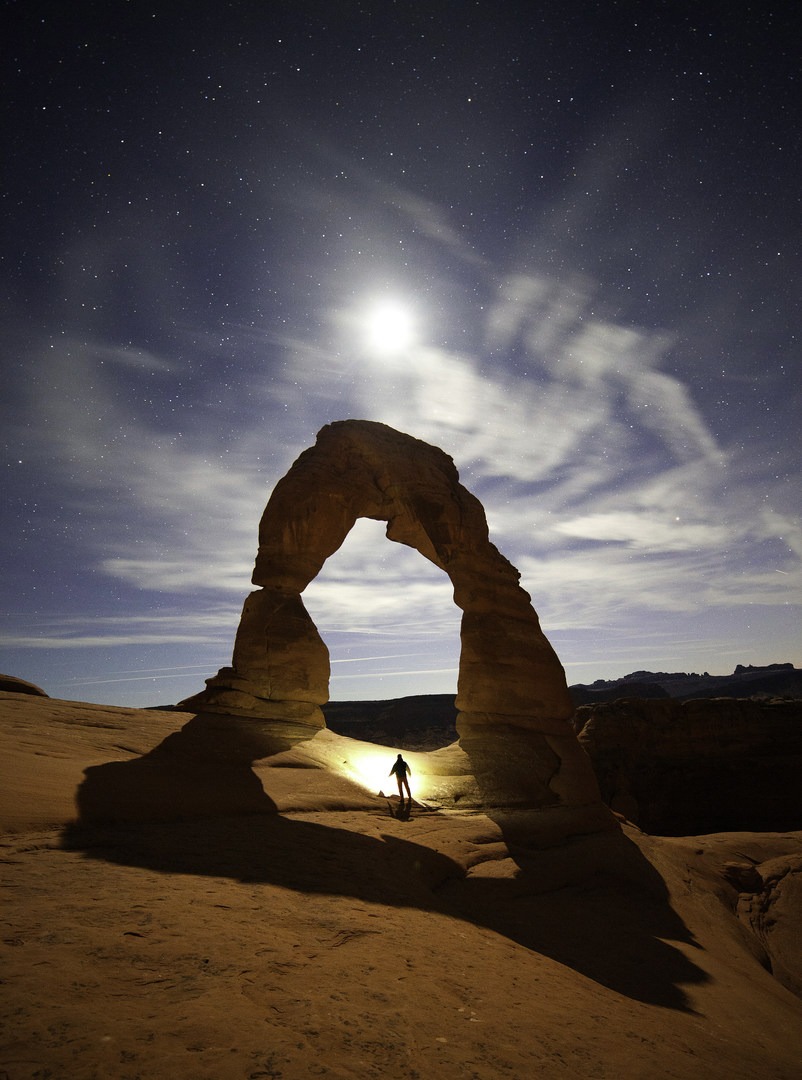You are here
Arches National Park Overview | Activities | Camping and Lodging | Permits | Weather | Pets
Arches National Park Overview

Located just a few miles northeast of Moab, Arches National Park is a small and easily accessible area that any visitor to Southeast Utah should make the time to see. Natural arch connoisseurs will have their hands full here: This park has the world's highest concentration of natural arches, which number just over 2,000. Many of these are smaller arches that may or may not be noticed along one of the park's many trails, of course, but several others are enormous formations that boggle the imagination. Long, short, towering, humble, stout, delicate, singular, clustered...the natural beauty and diversity of these arches lends this national park a completely unique character.
And while the park is named for its arches, the canyons, spires, boulders, and fins in this area are equally as mesmerizing. It all adds up to a wonderland of the improbable that is justifiably one of Utah's most popular national parks. Because of its relatively small size (just more than 76,000 acres) and its proximity to Moab, Arches is a very popular day trip. And if you only have a day to spend here, Arches will still amaze you. Take a few days to hike, rock climb, camp, or enjoy a ranger-led tour, however, and you'll begin to appreciate the fascinating geological story of this park on a whole new level.
The Navajo and Entrada sandstones that make up most of the red rock visible in Arches were once layers that were buried thousands of feet below the earth's surface where they were stressed, molded, and broken under subterranean pressures. As the Colorado Plateau began to uplift around 35 million years ago, these sand layers became exposed to surface elements that started to work relentlessly on the porous sandstone. Rain, wind, and freeze/thaw cycles sculpted and split the exposed and porous sandstone into the unlikely and beautiful shapes we see now. These formations are very much a product of processes that are still underway. An arch, for instance, may begin as a wall that is buckled and fractured until fins develop on its surface; when the soft sandstone at the center of this fin sloughs off in massive chunks or in runoff from persistent rains, the center drops out and an arch forms. This also means that, with slow and consistent erosion, the arch will fall. This is exactly what happened in 2008 when the Wall Arch, part of a giant fin that had eroded from the center, collapsed with little to no indication of structural weakness.

Park Avenue in Arches National Park. Photo by Denis Leblanc.
Activities
The scenic road that stretches from the main entrance at the south of the park to the Devils Garden area in the north end is the park's main corridor, and various hikes, viewpoints, and points of interest branch off from this road. Other roads leading to the Klondike Bluffs, such as the one leading through Salt Valley, may not be accessible depending on conditions. Expect crowded driving conditions unless you are visiting early or late in the day or in the off-season. Parking at popular trailheads frequently fills to capacity, so walking along the shoulder of the road to your trail is commonplace. Once you hit the trail and move away from the road for a mile or so, the crowds thin out and you can start to appreciate the natural landscape on its own terms.
Arches has trails for every taste, whether you are looking for short and sweet stops or longer and highly rewarding excursions. We've included a short list of hikes below, but many more trails, routes, and stops are available. Be sure to stop in at the visitor center when you arrive in the park to ask a ranger about current conditions and suggestions for your timeframe and abilities.
- Fiery Furnace: No trail, available by permit or tour only.
- Devil's Garden + Primitive Trail: 7.2 miles, difficult.
- Sand Dune Arch: 0.3 miles, easy.
- Delicate Arch: 3 miles, difficult.
- Tower Arch: 3.4 miles, difficult.
- The Windows Loop + Primitive Trail Loop: 1.5 miles, easy.
- Balanced Rock: 0.3 miles, easy and ADA accessible.
- Broken Arch Trail: 2 miles, easy.
- Skyline Arch: 0.4 miles, easy.
- Double O Arch: 4.2 miles, moderate.
- Landscape Arch: 1.6 miles, easy.
- Klondike Bluffs Trail + Tower Arch Hike: 2.7 miles, easy.
- Courthouse Wash Rock Art: 1 mile, easy.
- Double Arch: 0.5 miles, easy.
- Partition Arch: Short side hike from the Devils Garden Trail.
- Navajo Arch: Also accessible from a short side hike off of Devils Garden Trail.
- Park Avenue Hike: 2 miles, moderate.
- Dark Angel Hike: 5 miles, moderate.
- The Garden of Eden and Owl Rock: Easily accessible from the road.
Camping and Lodging
The only campground in the park, Devils Garden Campground, consists of 50 sites and two group sites. This is a relatively small number of sites for any national park, let alone one that receives 1.3 million visitors per year. Reservations are highly recommended between March and October. Outside of the reservation season campsites are first-come, first-served, so those who arrive early will have the best chances of securing a spot. This campground has potable water, flush toilets, and an amphitheater for ranger-led events, and each site has a picnic table and fire ring.
Campgrounds near Moab include Kane Creek and Ken's Lake, and there are also several BLM campgrounds and quite a few commercial campgrounds and RV parks in the area.
There are many additional lodging options, including rental homes, B&Bs and hotels, outside of the park in Moab and Castle Valley.
Permits
Due to extremely high use, the National Park Service issued a moratorium on backpacking in Arches National Park that began in September, 2016. The plan is for the park to assess user impacts and management strategies. For the time being, overnight trips into the Arches backcountry are not allowed. Day hikes into the Fiery Furnace need a permit that you can pick up from the visitor center, and reservations are available from April to September; alternately, you can choose to go on a ranger-led tour for the most educational experience.
Weather
Arches National Park is located in Southeast Utah on the Colorado Plateau, which means you can expect a broad range of temperatures across the seasons. Summertime highs typically exceed 90 degrees, but visitors should expect the occasional warm day almost any time of year. Many of the hikes in Arches are exposed and relatively shadeless, so the summer heat can be a big factor in planning your itinerary. Winters, on the other hand, can become quite cold. Average highs in November through February can reach the 40s and 50s, but a day in the 30s isn't uncommon. Lows dip down below the 20s. Wind exposure is significant in the park, and wind chill can be a factor for winter visits. Precipitation is scant; in an average year the park might see eight inches.
Pets
As is the case with most national parks, pets are allowed in the park with very heavy restrictions. Leashed pets can be walked along paved areas including roads, pullouts, overlooks, and campgrounds. Pets are not allowed on any trails or in the visitor center. Further, pets cannot be left unattended; weather extremes make leaving your pet in the car a potentially terrible decision. With Moab so close, it makes sense to research kennel options if you need to make arrangements for your pet while visiting Arches.
Logistics + Planning
Current Weather: Powered by Dark Sky






























Comments
Sign In and share them.